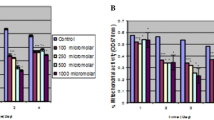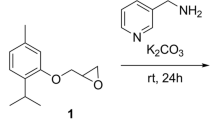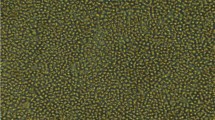Abstract
Lanthanum (La) is a rare-earth metal with applications in agriculture, industry, and medicine. Since lanthanides show a broad spectrum of applications there is an increased risk of contamination for humans. We examined the effects of lanthanum in Jurkat cells and human peripheral lymphocytes (HPL), and we found that it was cytotoxic and genotoxic on both cell lines. Additionally, HPL were more sensitive to La treatment than Jurkat cells and necrosis was the pathway by which La induced cytotoxicity. Vitamin E was able to diminish the DNA strand breaks induced suggesting that oxidative stress may be involved in the genotoxic process.


Similar content being viewed by others
References
Barbouti A, Doulias PT, Nousis L, Tenopoulou M, Galaris D (2002) DNA damage and apoptosis in hydrogen peroxide-exposed Jurkat cells: bolus addition versus continuous generation of H(2)O(2). Free Radic Biol Med 33:691–702. doi:10.1016/S0891-5849(02)00967-X
Collins AR, Fleming IM, Gedik CM (1994) In vitro repair of oxidative and ultraviolet-induced DNA damage in supercoiled nucleoid DNA by human cell extract. Biochim Biophys Acta 22:724–727
Feng J, Li X, Pei F, Chen X, Li S, Nie Y (2002) 1H NMR analysis for metabolites in serum and urine from rats administrated chronically with La(NO3)3. Anal Biochem 1:1–7. doi:10.1006/abio.2001.5471
Henriquez M, Armisén R, Stutzin A, Quest AF (2008) Cell death by necrosis, a regulated way to go. Curr Mol Med 8(3):187–206. doi:10.2174/156652408784221289
Lacaz-Vieira F, Marques MM (2004) Lanthanum effect on the dynamics of tight junction opening and closing. J Memb Biol 202:39–49. doi:10.1007/s00232-004-0718-3
Lee YJ, Shacter E (1999) Oxidative stress inhibits apoptosis in human lymphoma cells. J Biol Chem 274:19792–19798. doi:10.1074/jbc.274.28.19792
Liu H, Yuan L, Yang X, Wang K (2003) La(3+), Gd(3+) and Yb(3+) induced changes in mitochondrial structure, membrane permeability, cytochrome c release and intracellular ROS level. Chem Biol Interact 25:27–37. doi:10.1016/S0009-2797(03)00072-3
Lizon C, Fritsch P (1999) Chemical toxicity of some actinides and lanthanides towards alveolar macrophages: an in vitro study. Int J Radiat Biol 75:1459–1471. doi:10.1080/095530099139322
Naito M, Hashimoto C, Masui S, Tsuruo T (2004) Caspase-independent necrotic cell death induced by a radiosensitizer, 8-nitrocaffeine. Cancer Sci 95m:361–366. doi:10.1111/j.1349-7006.2004.tb03216.x
Palasz A, Czekaj P (2000) Toxicological and cytophysiological aspects of lanthanides action. Acta Biochim Pol 47:1107–1114
Palmer RJ, Butenhoff JL, Stevens JB (1987) Cytotoxicity of the rare earth metals cerium, lanthanum, and neodymium in vitro: comparisons with cadmium in a pulmonary macrophage primary culture system. Environ Res 43:142–156. doi:10.1016/S0013-9351(87)80066-X
Shi P, Huang Z (2005) Proteomic detection of changes in protein synthesis induced by lanthanum in BGC-823 human gastric cancer cells. Biometals 18:89–95. doi:10.1007/s10534-004-1812-9
Shorte SL, Omiyama M (1996) The effect of extracellular polyvalent cations on bovine anterior pituitary cells. Evidence for a Ca2+-sensing receptor coupled to release of intracellular calcium stores. Cell Calcium 19:43–57. doi:10.1016/S0143-4160(96)90012-3
Singh NP, McCoy MT, Tice RR, Schneider EL (1988) A simple technique for quantitation of low levels of DNA damage in individual cells. Exp Cell Res 175:184–191. doi:10.1016/0014-4827(88)90265-0
Wozniak K, Blasiak J (2002) Free radicals-mediated induction of oxidized DNA bases and DNA-protein cross-links by nickel chloride. Mutat Res 514:233–243
Yongxing W, Xiaorong W, Zichun H (2000) Genotoxicity of lanthanum (III) and gadolinium (III) in human peripheral blood lymphocytes. Bull Environ Contam Toxicol 64:611–616. doi:10.1007/s001280000047
Yu S, Yang X, Wang K, Ke Y, Qian ZM (2005) La3+-Promoted proliferation is interconnected with apoptosis in NIH 3T3 cells. J Cell Biochem 94:508–519. doi:10.1002/jcb.20303
Zhao H, Hao WD, Xu HE, Shang LQ, Lu YY (2004) Gene expression profiles of hepatocytes treated with La(NO3)3 of rare earth in rats. World J Gastroenterol 10:1625–1629
Author information
Authors and Affiliations
Corresponding author
Rights and permissions
About this article
Cite this article
Paiva, A.V., de Oliveira, M.S., Yunes, S.N. et al. Effects of Lanthanum on Human Lymphocytes Viability and DNA Strand Break. Bull Environ Contam Toxicol 82, 423–427 (2009). https://doi.org/10.1007/s00128-008-9596-1
Received:
Accepted:
Published:
Issue Date:
DOI: https://doi.org/10.1007/s00128-008-9596-1




